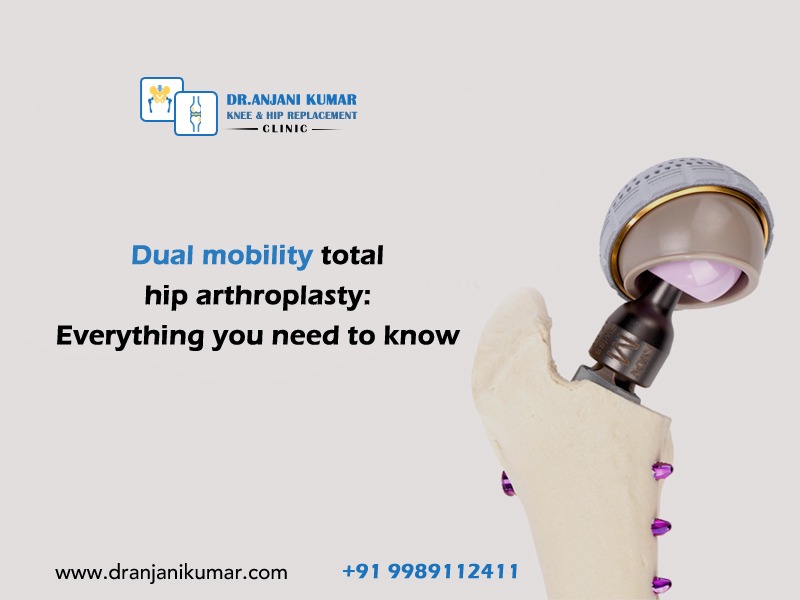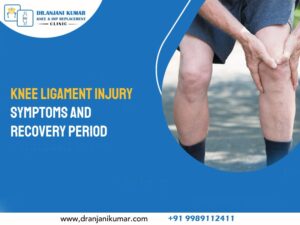Dual mobility total hip arthroplasty (THA) is a surgical procedure that replaces a damaged or arthritic hip joint with an artificial one, reducing the risk of dislocation and improving joint stability. This procedure is particularly beneficial for patients at a higher risk of hip dislocation or instability, as it consists of multiple components. It is a more effective alternative to traditional single-bearing surface hip replacements.
Why and when does the surgeon recommend dual mobility total hip arthroplasty?
Surgeons recommend dual mobility total hip arthroplasty (THA) for specific patient populations and clinical scenarios based on individual factors, medical history, and the surgeon’s assessment in common situations.
- High risk of hip dislocation:
- Two-way mobility Recovery from THA is a long process that calls for patient care and follow-up consultations. You will receive customised advice from your surgeon and rehabilitation staff to provide the greatest possible surgical outcome.
- Anatomical factors that predispose an individual to instability or past hip dislocations.
- Elderly patients:
- Elderly patients are more prone to falls and may have weakened hip joint structures.
- Dual mobility THA can provide greater stability and reduce the likelihood of dislocation in this patient group.
- Revision surgery:
- Patients who have undergone previous hip surgeries and are at a higher risk of dislocation may benefit from dual mobility THA during revision surgery.
- Neurological or muscular disorder:
- Patients with neurological conditions, such as Parkinson’s disease or muscular disorders that affect hip muscle strength may be recommended for dual mobility THA to enhance hip joint stability.
- Hip fractures:
- Some hip fractures, especially those involving the femoral neck, can lead to hip instability.
- Restoring stability and function in these situations with dual mobility THA may be possible.
- Congenital hip dysplasia:
- Individuals born with hip dysplasia may require hip replacement surgery if the hip socket doesn’t form correctly.
- THA with dual mobility can address hip instability.
- Complex hip anatomy:
- Patients with complex hip anatomy or deformities may benefit from dual mobility THA to improve joint stability and function.
- Preventative measures:
- In some cases, surgeons may recommend dual mobility THA as a preventative measure, especially if they anticipate a higher risk of dislocation post-surgery.
Dual mobility THA can reduce hip dislocation risk, but it may not suit every patient. Surgeons evaluate each patient’s unique circumstances, considering age, health status, hip joint condition, and lifestyle. Patients considering hip replacement surgery should consult an experienced orthopaedic surgeon for a thorough assessment and discussion on the most appropriate surgical approach, whether it involves dual mobility THA or another technique.
Essential precautions and guidelines to be followed for dual mobility total hip arthroplasty:
Post-surgery precautions and recommendations are crucial for successful recovery and minimising complications following dual mobility total hip arthroplasty (THA).
Before dual mobility total hip arthroplasty:
- Medical evaluation:
- Before surgery, you undergo a comprehensive medical evaluation to assess your overall health and fitness for the procedure.
- The primary goal is to identify any underlying medical conditions that could affect your ability to tolerate surgery and anaesthesia.
- Medication review:
- Your surgeon reviews all medications you are taking, including prescription, over-the-counter, and herbal supplements.
- Adjustments to medications may be made in consultation with your healthcare provider.
- Quit smoking:
- If you smoke, it is strongly encouraged to quit or reduce smoking before surgery.
- Smoking might slow the healing process and raise the risk of complications.
- Weight management:
- Achieving and maintaining a healthy weight is recommended before surgery.
- Excess weight can place additional stress on the hip joint and impact recovery.
- Physical conditioning:
- Engage in preoperative exercises prescribed by your surgeon or physical therapist.
- These exercises are designed to strengthen your hip and improve your overall physical condition, which can facilitate postoperative rehabilitation.
- Home preparation:
- Modify your home environment to ensure it is safe and accessible for your recovery.
- Remove tripping hazards, install grab bars, and arrange for assistance if needed.
After dual mobility total hip arthroplasty:
- Follow the surgeon’s instructions:
- After surgery, it is essential to strictly adhere to all postoperative instructions provided by your surgeon and healthcare team.
- Pain management:
- Take prescribed pain medications as directed to manage postoperative discomfort and pain.
- Inform your healthcare practitioner right away if you experience any unexpected or severe pain.
- Hip precautions:
- Follow specific hip precautions to reduce the risk of dislocation.
- This includes avoiding certain movements and positions, such as crossing your legs or excessive hip bending.
- Assistive devices:
- Use assistive devices like crutches, a walker, or a cane, as recommended by your surgeon.
- These devices provide support and help you move safely during the early stages of recovery.
- Physical therapy:
- Attend all prescribed physical therapy sessions.
- Physical therapists will guide you through exercises to improve hip joint mobility, strength, and balance.
- Wound care:
- Maintain proper wound care by keeping the surgical incision clean and dry.
- Follow your surgeon’s instructions for dressing changes and showering restrictions.
- Medication compliance:
- Take prescribed medications, including antibiotics, as directed to prevent infection.
- Monitor for complications:
- Be vigilant for signs of complications, such as infection, blood clots, or implant issues.
- Inform your surgeon right away of any worrying signs.
- Nutrition:
- Maintain a balanced diet to support healing and bone health.
- Ensure you are getting adequate calcium and vitamin D.
- Follow-up appointments:
- Attend all scheduled follow-up appointments with your surgeon for monitoring and assessment of your progress.
- Activity restrictions:
- Avoid high-impact activities, strenuous exercises, and movements that could strain the hip joint.
- Consult with your surgeon before resuming any sports or demanding activities.
- Driving restrictions:
- When it’s safe to get behind the wheel again, heed the advice of your surgeon.
The medical evaluation post dual mobility THA ensures recovery progress, promptly identifying and addressing any issues or complications, with the surgeon and healthcare team monitoring postoperative health for guidance and interventions.
General timeline for recovery after dual mobility THA:
The length of recovery following a dual mobility total hip replacement varies based on the patient’s health, age, the degree of the surgery, and the post-operative rehabilitation plan.

- Hospital stay:
- After surgery, the majority of patients stay in the hospital for a few days.
- During this time, the medical team monitors your condition, manages pain, and begins early mobilisation.
- Post-operative period(days 1-7):
- In the initial days following surgery, you will gradually regain consciousness and begin moving with the assistance of physical therapists.
- Currently, pain management medications are utilised
- You may be encouraged to perform gentle range-of-motion exercises while adhering to weight-bearing restrictions determined by your surgeon.
- Discharge and home recovery (days 7-14):
- Within a week of surgery, most patients are discharged from the hospital.
- You will receive instructions for wound care, medications, and home exercises.
- It’s essential to have a supportive home environment with necessary assistive devices (like a walker or crutches) and arrangements for home healthcare or physical therapy if needed.
- Weeks 2-6:
- During this period, you’ll continue to work on regaining mobility and strength through outpatient or home-based physical therapy.
- As your surgeon directs, you may gradually put more weight on the operated leg.
- You’ll likely be able to perform daily activities with increasing independence, but high-impact and strenuous exercises are restricted.
- Weeks 6-12:
- The patient underwent physical therapy and exercise to enhance hip joint function and muscle strength.
- Most patients can expect significant improvement in mobility and a reduction in pain by this stage.
- You may start incorporating more activities into your daily routine, but you should still avoid high-impact sports or activities.
- Months 3-6:
- By the third month, many patients have achieved a good level of mobility and are experiencing less pain.
- Physical therapy sessions may continue, focusing on functional activities and improving endurance.
- You can gradually reintroduce low-impact exercises and activities under the guidance of your surgeon or physical therapist.
- Beyond six months:
- Complete recovery and return to normal activities can take up to a year or longer.
- Maintaining a healthy lifestyle, including regular exercise, is important to optimise long-term outcomes and minimise the risk of complications.
Dual mobility THA recovery is a gradual process, requiring follow-up appointments and patient care. Your surgeon and rehabilitation team will provide personalised guidance to help you achieve the best possible outcome from the surgery.
About Dr Anjani Kumar
As an orthopaedic surgeon in Hyderabad, I try to provide patients with as many options as possible for hip and knee treatments to help each patient have the greatest results. I carefully consider the specific sorts of injuries and need to be comfortable offering a specialised solution before recommending the best course of therapy for each patient. My patients’ enhanced mobility and pain reduction are always my top priorities, as these will enable them to resume an active lifestyle. In more severe cases, especially when the joint has collapsed, or the bone has suffered extensive deformation, knee replacement surgery may be advised.
Knee replacement surgery may be recommended in advanced cases, especially if the joint has collapsed or the bone has become severely deformed.
Dr. Anjani Kumar has 20 years of experience and successfully performed 2000 knee replacement surgeries, 350 hip replacement surgeries, and 500 pelvic acetabular surgeries throughout his career. Please get in touch with us on Mobile: at +91 9989112411 and by E-mail: anjanikumar@ gmail.com





